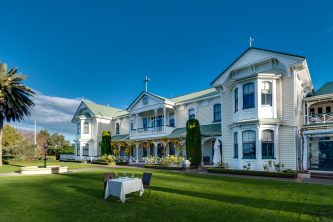A heritage like no other – Mission Estate Winery
Wednesday 12th March, 8pm
Door Price: Members $6 / Guests $10
 Reaching NZ shores in 1838, pioneering French missionaries founded a legacy. From their many accomplishments now interwoven throughout history came New Zealand’s first winery, Mission , in 1851. Their inspiration, a legacy, continues.
Reaching NZ shores in 1838, pioneering French missionaries founded a legacy. From their many accomplishments now interwoven throughout history came New Zealand’s first winery, Mission , in 1851. Their inspiration, a legacy, continues.
Today their vineyards span two of NZ’s best winegrowing regions; Hawkes Bay and Marlborough. Hawkes Bay vineyards in the Gimblett Gravels and Taradale focus on Chardonnay, Merlot, Cabernet Sauvignon and Syrah; but also include small clocks of other varietals such as Semillon and Cabernet Franc.
Whereas, their Marlborough properties, perfect for producing cool climate wine styles, grow Sauvignon Blanc, Pinot Noir and Pinot Gris.

Paul Mooney, our passionate winemaker since 1979, was trained by the Marist Brothers themselves, Paul imparts the very essence of Mission’s French heritage winemaking philosophy into both our Hawke’s Bay and Marlborough wines.
We consider ourselves guardians of our heritage and our land, and for more than 20 years we have been proud to be a founding member of Sustainable Winegrowing New Zealand. In 1998, we were also one of the first wineries in New Zealand to be certified with the internationally recognised environmental management system ISO 14001.
We start with 2024 Mission Estate Rosé as our conversation/entry tasting followed by:
- 2023 The Gaia Project Pinot Gris
- 2024 Mission Estate
- 2023 Reserve Chardonnay
- 2019 Mission Reserve Cabernet Franc
- 2020 Mission Reserve Cabernet Sauvignon
- 2023 Reserve Syrah
SPECIAL NOTE: The door prize on tasting night is going to be something a little special, namely a bottle of Lanvin Brut Champagne NV. Ticket prices for this will be $2 each.











